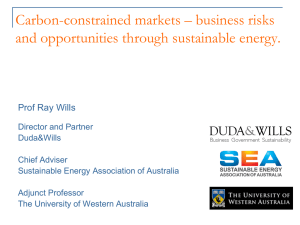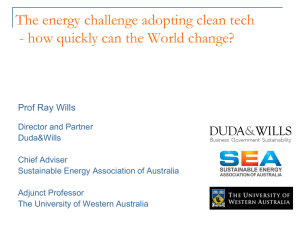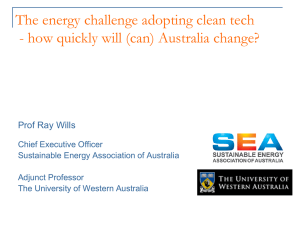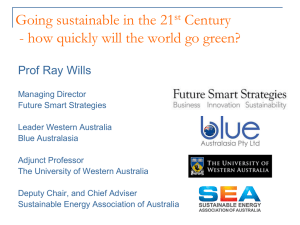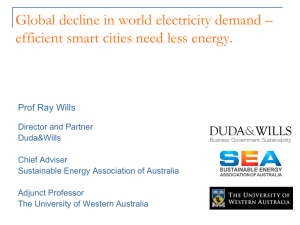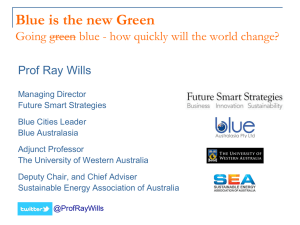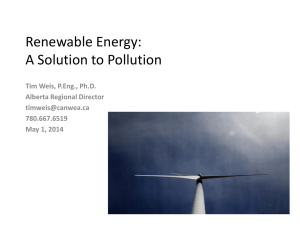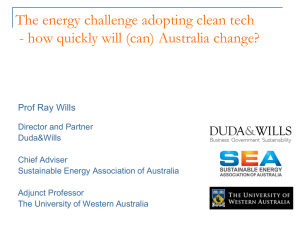Wills-adoptingcleantech-Kenya-AHC2
advertisement
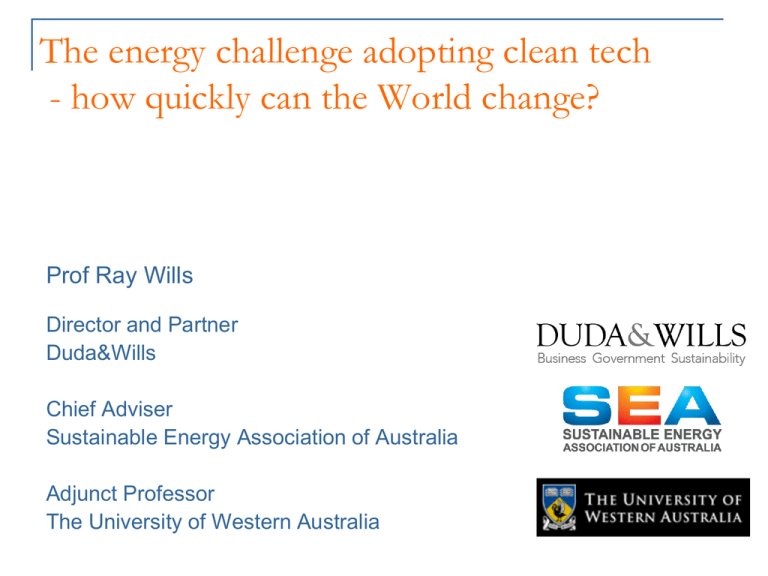
The energy challenge adopting clean tech - how quickly can the World change? Prof Ray Wills Director and Partner Duda&Wills Chief Adviser Sustainable Energy Association of Australia Adjunct Professor The University of Western Australia About Australia A warming of 1.0°C is sufficient to move climate belts about 150 km south. A regional temperature change of 2 °C likely to have a serious impact on most life forms, and on most ecosystems and agricultural areas. Changes by 2040 About Western Australia About WA Climate is key determinant of agriculture - changes in climate will impact on crops and livestock. Rising temperatures will cause a shift in budburst, shorter growing seasons, earlier harvest dates, lower crop quality, changes in soil temperatures. Wheat growing areas in SW WA seriously impacted Northern wheatbelt likely to disappear, south reduced. Wipes out most of an industry worth more than $2 billion. Climate is a key influence in grape selection. Shifting rainfall patterns and drier conditions will change the way vineyards operate and reduce the wine crop. WA produces around 5% of all Australian wine, about 25% of wine in super-premium and ultra-premium categories. Adoption of technology The natural turnover and retirement of appliances, buildings and vehicles can bring about a modest penetration of sustainable energy in the next ten years. However, adoption of new technology is often not just ‘natural’ The transition to sustainable energy, like many new technology shifts, will be more rapid with changes favoured by: policy measures and regulation; consumer sentiment; pricing advantage. Roger’s diffusion curve Technology adoption rates – US Will electric cars be dishwashers or VCRs? (Will there ever be any more dishwashers??) NY Times Technology adoption rates - vehicles Zoepf 2011 Technology adoption rates - vehicles Zoepf 2011 Technology adoption - manufacturers Zoepf 2011 Technology adoption rates Can historic deployment rates be used to describe future technologies? Expect some similarities – just faster! Small-scale deployment for approximately five years - exponential growth and an inflection point ten or more years after first application Is there an opportunity for disruptive technology entry? Beginnings of disruptive innovation may be in market innovations, Vehicle ownership model (eg Better Place) could rapidly change the how and what is purchased Roof top solar – companies may own the panels on your roof Technology adoption rates www.kickstarter.com Technology adoption rates Marked decrease in developmental lag Innovation/development of new products Supply side capabilities Market competition Growing consumer expectations Higher level of communication between consumers - blogspace Fleet/building/operations managers – and CFOs Regulation Energy security Trends in car prices and CO2 2002-2010 How clean are Europe’s cars? Global investment in electricity 500 450 400 350 300 Fossil dethroned* BNEF Renewable 250 Fossil BAU (estimated) BNEF IEA (estimated) 200 150 100 50 0 2004 2005 2006 2007 2008 2009 2010 2011 Global renewables Renewable energy growth Data IEA Global renewables 2013? Data UNEP Global electricity … IEA Energy Statistics 25 000 000 20 000 000 15 000 000 10 000 000 Coal/peat Oil World Statistics on the Web: http://www.iea.org/stats/index.asp Electricity generation by fuel Natural gas Hydro Biofuels & waste Geothermal/solar/wind For more detailed data, please consult our on-line data service at http://data.iea.org. Nuclear 0 1971 1973 1975 1977 1979 1981 1983 1985 1987 1989 1991 1993 1995 1997 1999 2001 2003 2005 2007 2009 5 000 000 © OECD/IEA 2011 GWh Global electricity growth - Europe Australian renewables 2011… The transformation of Australia’s energy mix has begun – in 2011 new electricity generation construction 25% solar, 31% gas and 33% wind. Coal-fired power currently 75% of Australia’s total generation - in 2011 only 14% of new investment was coal. This is still behind the average world-wide investment in renewable energy – China’s economy 8 times larger than Australia, investment in renewables over 20 times larger! Australia’s Clean Energy Future $5.5 billion Energy Security Package Energy Security Council EOI for highest emitting generators $10 billion Clean Energy Finance Corporation $9.2 billion Jobs and Competitive Package $1.2 billion Clean Technology Program $1 billion Biodiversity Fund and other land-based programs $330 million for Low Carbon Communities Australia’s Clean Energy Future MANUFACTURING AND INDUSTRY $1.2 billion Clean Technology Program including: $800 million Clean Technology Investment Program; $150 million from the $200 million Food and Foundries; $200 million Clean Technology Innovation program. $300 million Steel Transformation Plan $200 million Regional Structural Adjustment Fund Australian electricity … Data ABARES Australian electricity consumption 2012… Australian electricity demand 2012… Data AEMO Electricity market projections – WA Solar on Australian homes Sustainable energy and energy efficiency Energy efficiency in all forms Distributed, renewable energy Known costs, resource life 1000++ years Stored energy in commodities, desal Energy storage key to: improved energy delivery increased reliability reduced emissions Technology energy use www.epri.com Global electricity growth Rapid change - Personal mobility Private transport Fuel efficiency, other energy sources Transport Energy storage key New technologies may be disruptive Electric mass transit Commercial vehicles Smith Newton electric truck Mega electric diesel hybrids London Bus Haul Pak + Earthmover Mitsubishi Fuso Honda prime mover Oshkosh Military Vehicle Flying and floating fuels February 25, 2008 – Virgin Atlantic Stages the First Biofuel Flight October 30, 2007 - U.S.A.F. Tests New Synthetic Fuel on Plane February 14, 2011 – Qantas follows US Military to algae biofuels September 13, 2011 – US Navy announces by 2016 Green Strike Group, powered by renewable diesel-electric engines, nuclear power and aviation biofuels, is able to operate independent of fossil fuel supply line threat or disruption Smart grids, smart houses (and farms) Integrated energy planning Smart grids to coordinate the actions of devices such as loads & generators Green cities Global Australia Tianjin Eco-City China Ulsan Ecocity Korea Masdar City UAE City of Sydney – 70% CO2 reduction by 2030 City of Melbourne Stirling City Centre, Perth City of Fremantle Yanchep – 2 x 100 000 Local government critical www.seaaus.com.au
